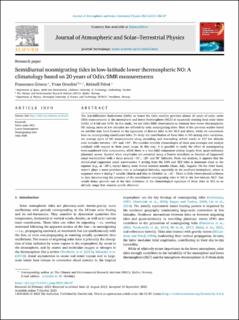| dc.contributor.author | Grieco, Francesco | |
| dc.contributor.author | Orsolini, Yvan Joseph Georges Emile G. | |
| dc.contributor.author | Pérot, Kristell | |
| dc.date.accessioned | 2023-11-01T10:00:46Z | |
| dc.date.available | 2023-11-01T10:00:46Z | |
| dc.date.created | 2023-10-16T11:55:35Z | |
| dc.date.issued | 2023 | |
| dc.identifier.citation | Journal of Atmospheric and Solar-Terrestrial Physics. 2023, 252, 106147. | en_US |
| dc.identifier.issn | 1364-6826 | |
| dc.identifier.uri | https://hdl.handle.net/11250/3099933 | |
| dc.description.abstract | The Sub-Millimetre Radiometer (SMR) on board the Odin satellite provides almost 20 years of nitric oxide (NO) measurements in the mesosphere and lower thermosphere (MLT) at equatorial crossing local solar times (LSTs) of 6 AM and 6 PM. In this study, we use Odin/SMR observations to estimate how lower thermospheric NO mixing ratios at low latitudes are affected by solar nonmigrating tides. Most of the previous studies based on satellite data have focused on the signatures of diurnal tides in the MLT and above, while we concentrate here on nonmigrating semidiurnal tides. To study the contribution of these tides to NO mixing ratio variations, we average pairs of NO measurements along ascending and descending orbital tracks at 107 km altitude over latitudes between −40°and +40°. We consider monthly climatologies of these pair-averages and analyse residuals with respect to their zonal mean. In this way, it is possible to study the effect of nonmigrating even-numbered tidal components, albeit there is a non-tidal component arising largely from quasi-stationary planetary waves. Spectral wave amplitudes are extracted using a Fourier transform as function of (apparent) zonal wavenumber with a focus around −30°, −20°and 30°latitudes. From our analysis, it appears that the semidiurnal (apparent) zonal wavenumber 4 arising from the SW6 and SE2 tides is dominant close to the equator (e.g., at −20°), except during some boreal summer months (June, July, August). On the other hand, wave-1 plays a more prominent role at subtropical latitudes, especially in the southern hemisphere, where it surpasses wave-4 during 7 months (March and May-to-October) at −30°. There is little observational evidence to date documenting the presence of the semidiurnal nonmigrating tides in NO in the low-latitude MLT. Our results hence provide one of the first evidences of the climatological signature of these tides in NO, in an altitude range that remains poorly observed. | en_US |
| dc.language.iso | eng | en_US |
| dc.rights | Navngivelse 4.0 Internasjonal | * |
| dc.rights.uri | http://creativecommons.org/licenses/by/4.0/deed.no | * |
| dc.title | Semidiurnal nonmigrating tides in low-latitude lower thermospheric NO: A climatology based on 20 years of Odin/SMR measurements | en_US |
| dc.title.alternative | Semidiurnal nonmigrating tides in low-latitude lower thermospheric NO: A climatology based on 20 years of Odin/SMR measurements | en_US |
| dc.type | Peer reviewed | en_US |
| dc.type | Journal article | en_US |
| dc.description.version | publishedVersion | en_US |
| dc.rights.holder | © 2023 The Author(s). Published by Elsevier Ltd. | en_US |
| dc.source.volume | 252 | en_US |
| dc.source.journal | Journal of Atmospheric and Solar-Terrestrial Physics | en_US |
| dc.identifier.doi | 10.1016/j.jastp.2023.106147 | |
| dc.identifier.cristin | 2185096 | |
| dc.relation.project | NILU - Norsk institutt for luftforskning: 122069 | en_US |
| dc.source.articlenumber | 106147 | en_US |
| cristin.ispublished | true | |
| cristin.fulltext | original | |
| cristin.qualitycode | 1 | |

